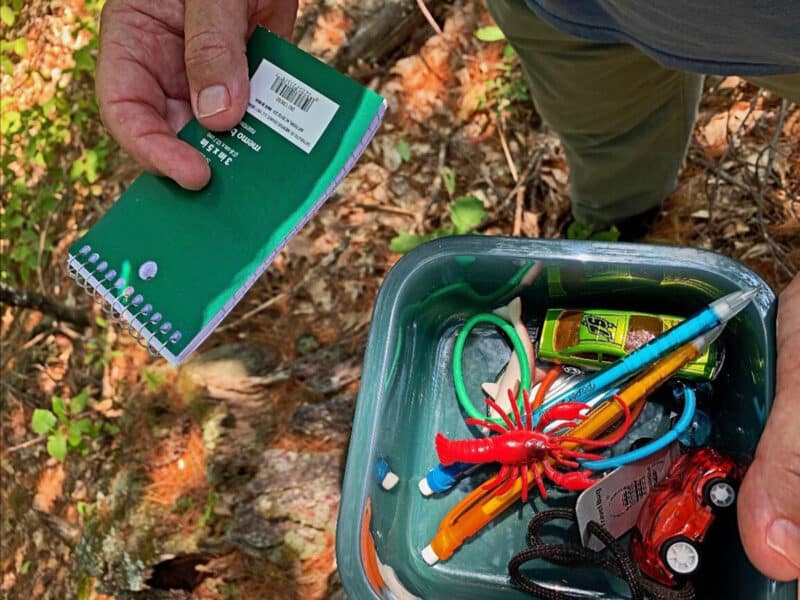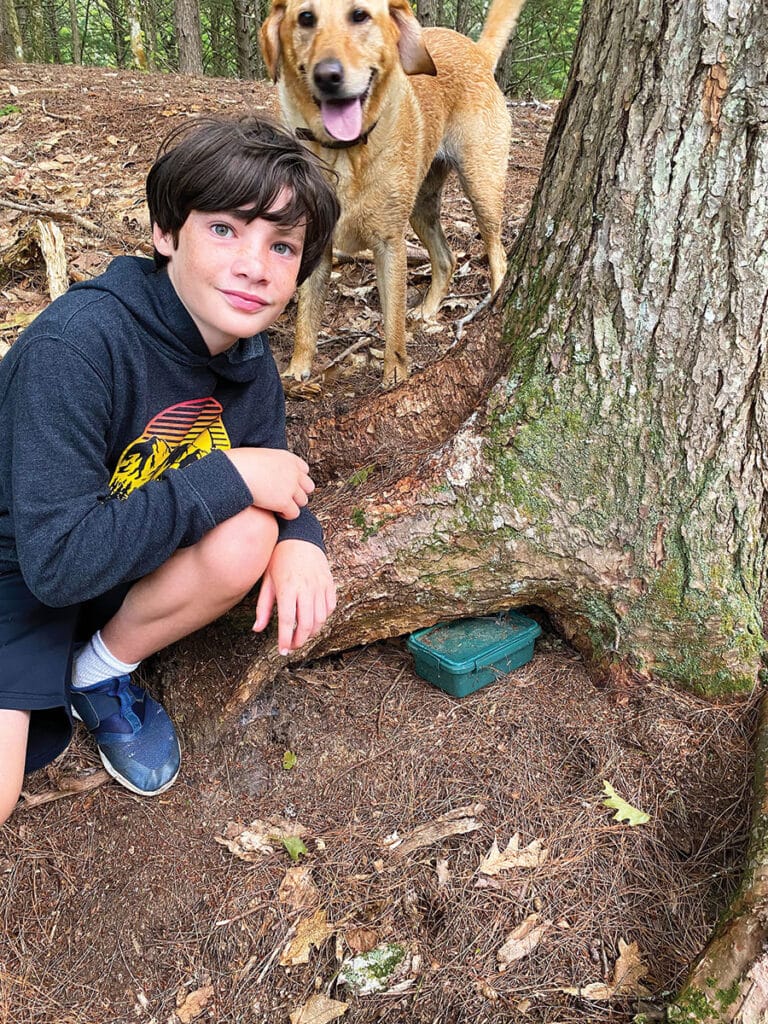by Dr. Sarah Treanor Bois, PhD
Director of Research & Education at the Linda Loring Nature Foundation
We’ve had a marvelous fall with warmer weather than ever before. This has led to many more outdoor adventures, longer hikes, and even some late fall ocean swims.
However, as we settle in towards real winter on Nantucket, the winds will whip up and the bitter cold will eventually set in. But that doesn’t mean you have to stay indoors. You might just need an excuse to get outside. In the dead of winter, as the sun sets earlier, I know that I sometimes need an excuse to walk a little further or to explore a new spot. One answer to this problem for me, especially when my son was young, was to go on a treasure hunt. Welcome to the wonderful world of geocaching!
I last wrote about geocaching in 2017 (yesterdaysisland.com/hunt-real-treasure- geocaching/), but it’s time to update the what, how, when, and where for the island.
So, what is geocaching? Geocaching is a real-world, outdoor treasure hunting game. At its most basic, geocaching is navigating to a specific set of coordinates and then attempting to find the geocache (usually some kind of container) hidden at that location. But at its heart, geocaching is an old-fashioned treasure hunt looking for an “x-marks-the-spot” kind of adventure. There are caches for all levels of expertise, types of mobility, and degrees of mental difficulty.
Geocaching is based on a long tradition of hiding clues somewhere around the world in hopes that someone else, someday will find it. While it was officially started in 2000, geocaching is based on older activities like letterboxing (which began in 1854). It uses orientation skills, problem solving, and a handheld GPS (usually a phone) to make discoveries all over the world.
There are currently 57 geocaches hidden around Nantucket. They vary from difficult and miniscule, to easier and big, but more on that later. The number of caches is down from my 2017 article when there was a more active geocache community and more than 80 active geocaches. But there are still plenty to find! Some represent conservation and natural areas while others are on historic sites that may open your eyes to new locations.
How to get started? First thing is to sign up for a free account at geocaching.com. There are paid versions with more finds, but there are plenty with the free version to start. The next thing to do is to create a name for yourself or your family. Be creative with this one: find a handle that works with your crew’s personality. Part of geocaching is being secretive about the whole thing, so you don’t want to give away your real name.
Load the geocache free app onto your phone. Geocachers previously used map and compass, so participation was limited. Now, with phones in our pockets, we are all armed with tiny supercomputers. The app uses your phone’s GPS to navigate to nearby caches. Look for what’s near you, and choose a cache to find. I suggest starting with an area that is familiar. In researching this article, I realized that there are newer geocaches I never knew existed on some of my favorite walking trails.
Before you go out, be sure to read the description and some comments. It’s important to start on a cache that isn’t too difficult, so you get the feel for what you should be looking for. Reading the last few comments also helps to know if the cache was recently found. There are several now that are still listed as “active” but actually haven’t been found in many months. This can happen when someone steals a cache (which almost never happens) or, more likely, when it goes into disrepair and/or washes away. Recently, a geocacher on Nantucket moved off-island, so some of her caches have degraded.
When you open the app and click on a cache, for example the one labeled “Squam Swamp,” there will be ratings for difficulty, terrain, and size. This refers to where the cache is and how hard it is to find. Squam Swamp cache is the easiest difficulty level (1 star) and the terrain is 1.5 stars. The size is listed as “regular” – usually that means about the size of a Tupperware container. Many Nantucket caches are relatively easy, but as you gain experience, it can be fun to challenge yourself.
The size refers to what is actually hidden. Many are modified Tupperware containers, old ammo cases or containers, and sometimes cylindrical tubes. People who really like a challenge set up fake birdhouses, pretend pinecones that open, and even little Lego boxes. I’ve had a few fake rocks that tormented me when I tried to find them in the woods. Anything listed as “nano” in the size category will be extremely small. I once found a magnetic nano the size of a quarter stuck to the clapper of a bell (I won’t reveal that location, but it was a fun find for sure!). Inside the containers are treasures to be traded. You never want to take anything without leaving something in return.
The description listed will have info about the location. It might include where to park, what to look for or information about the property. Sometimes there is little in the description, and it’s purposefully vague. The description for the Squam Swamp cache talks about who owns the property (the Nantucket Conservation Foundation) and what trail marker number to walk to in order to get close to the hidden location. Some caches also have additional hints that are optional. On Nantucket, some of the historic caches have detailed descriptions of the site and its history. The cache labeled “Oldest House & Historic Garden” has detailed history of one of the signature properties of the Nantucket Historical Association. This is great for families. Kids get hooked on geocaching for the treasure part, but you can get them to learn more about the island and its history along the way.
So, you found a cache, now what? What’s even in it? Treasure! By “treasure,” this usually means simple things like small trinkets or tokens that will fit in a small box waiting to be traded. Erasers, matchbox cars, pencils… a treasure trove of tchotchkes. Another important item in a cache is the log book. This is the record of you finding the cache. Sign your geocaching code name and the date and often a word or two about your adventure and you’re done. Remember not to take the pencil that it used for signing in the cache! You can also log the find on your geocaching app. Remember, if you take a photo, please don’t post one that will give away the exact location. No spoilers!
Who’s hiding these things anyway? To officially hide a cache and have it listed on the geocaching website, you have to demonstrate some experience and understanding of the general rules. Hiding caches is another lesson entirely with lots of rules and suggestions. You should get your feet wet first with just finding several. Geocaching.com has a lot of great info about hiding and seeking caches if you need more (www.geocaching.com/play/hide).
In addition to the steps to get started there is some geocaching etiquette that must be observed.
- First of all, don’t let Muggles (i.e. those who aren’t geocaching with you) see what you’re doing. If you’re on a path poking around looking for a cache, be discreet when others come along.
- When you do find a cache, only take something if you leave something of equal or lesser value. Don’t put sticks or leaves as a trade for a keychain, that’s just poor form. I generally keep a small bag of trinkets in my car just for this purpose. The take-it-or-leave-it is a great resource for geocaching treasures.
- Do not put food in the cache. This just invites creatures of all sorts to wreak havoc on the cache, ruining it for everyone else.
- DO NOT MOVE THE CACHE! While that may seem obvious, it can be tempting to move it just a bit or hide it “a little better.” Leave it just as you found it, and then everyone will have a chance to find the cache after you.
- On-island, you also want to watch out for poison ivy and ticks – hazards of any outdoor adventure.
Geocaching on Nantucket is a great way to learn more about the island even if you’re a seasoned old salt. There are people who make day trips to the island just to try and find as many caches as they can before catching the last boat. Whether they travel by bike or car, they often see more of the island than people who spend much more time here.
Geocaching is also a great hobby for travelling. When driving up to Maine or on a recent car trip to North Carolina, we like to find caches at various off ramps and rest stops along the way. It breaks up the car ride and gets us to pull off where we never would have stopped. Since caches are supposed to be hidden on publicly accessible land, we often find “hidden gems” of parks and properties we would not have found otherwise.
So get out there are enjoy the geocaching community. The more people who participate on the island, the more and better caches there will be to find. Hope to see you on the trail!




